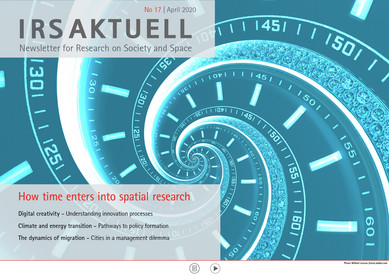Main Content
How time enters into spatial research
No 17 | April 2020

That the IRS researches spaces and spatiality is well known. In its new research programme “Cities and Regions as Arenas for Action” (2019-2021), the institute focuses on collective conceptual work on “spatio-temporal dynamics”. What does this mean? For the researchers it involves finding out how the diverse objects of research at the IRS manifest, spread, and change in space and time. To this end, theoretical and methodological tools are required: How can one understand time and “temporality”? How do these relate to our established research object, space? By what means can this interrelation be investigated? And finally: What new insights does this perspective bring?
Space and time are the two central systems of ordering in human experience and thought. Space orders those things that occur together, while time orders them sequentially (one after the other). For many of the questions posed by scientists, it makes sense to analytically separate space from time. A map, for instance, is an appropriate medium for revealing spatial structures, but it always carries the cost that processes underlying such structures must be, so to speak, frozen. Conversely, social-science models of processes, such as innovation or crisis processes, offer a good insight into the dramaturgy of the typically sequential actions, but they suppress the spatially unequal distribution of those participating and affected, their causes and impacts.
The IRS has already examined temporal orders and used them in connection with space. Since 2015, for instance, the research department “Dynamics of Communication, Knowledge and Spatial Development” has investigated social innovation processes in rural communities. The department “Institutional Change and Regional Public Goods” has examined institutional transformation processes in the supply of infrastructures. Finally, in the Department for Historical Research the IRS explores recent German planning history – thus with an explicit bearing on time. Still, in the current research programme the institute seeks to pursue this theme further. Spatio-temporality will be promoted to an independent research dimension and category of analysis that, theoretically and methodologically underpinned, could perhaps lead to completely new accounts of social phenomena – such as why some policy attempts to exercise influence succeed where others fail.
We are used to thinking of time in the sense of the notion of “chronos” – as something objectively given. It flows uniformly, always in the same direction, independent of an observer, and the same in all places. Various means of recording time, such as watches and calendars, appear to us to verify this concept. Social-science approaches, on the other hand, emphasise the socially constructed character of time: time and temporality are based upon social conventions, negotiated between actors, enforced by those holding power, and prescribed as norms. The necessity of synchronising time across many locations and of measuring it uniformly only first emerged in the 19th century, for example. Railway networks were built, and timetables were established. From a social-science perspective, it is interesting to examine how the actors involved – such as railway companies, administrators, traders, clock makers, and passengers – came to a common understanding of the way in which time should be measured, displayed, documented, and used. It is through such procedures that the notions of time which a society constructs changes, and thus also what it is that people experience as the “objective” truth about time.

